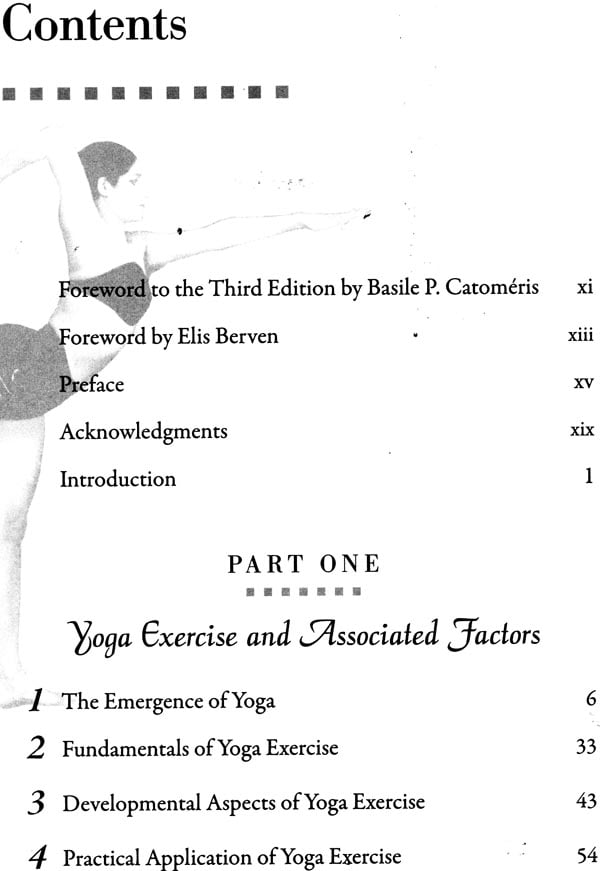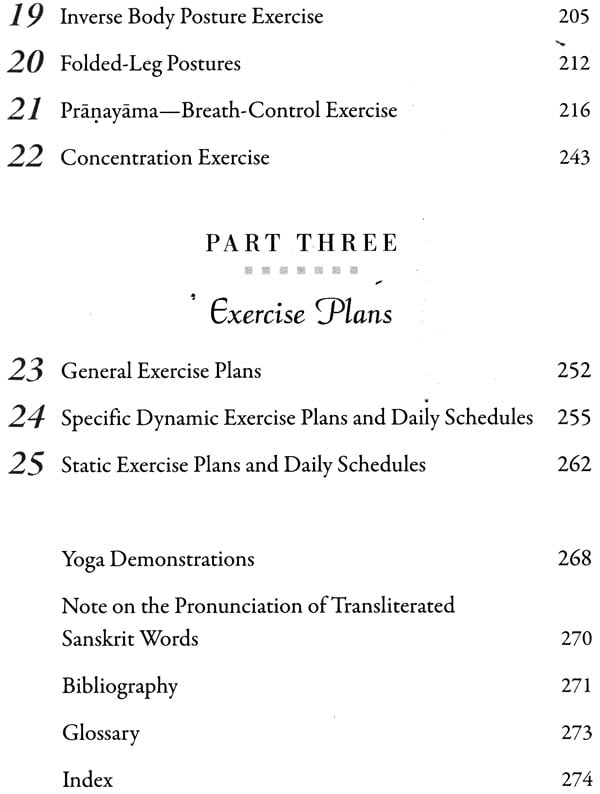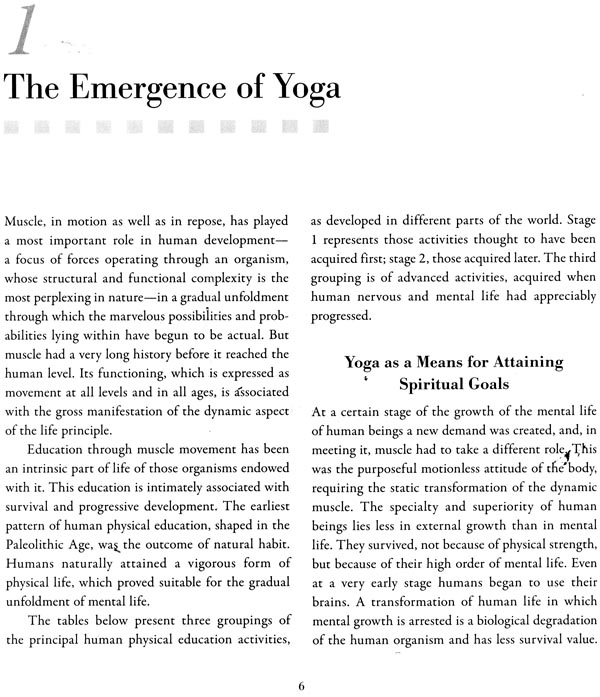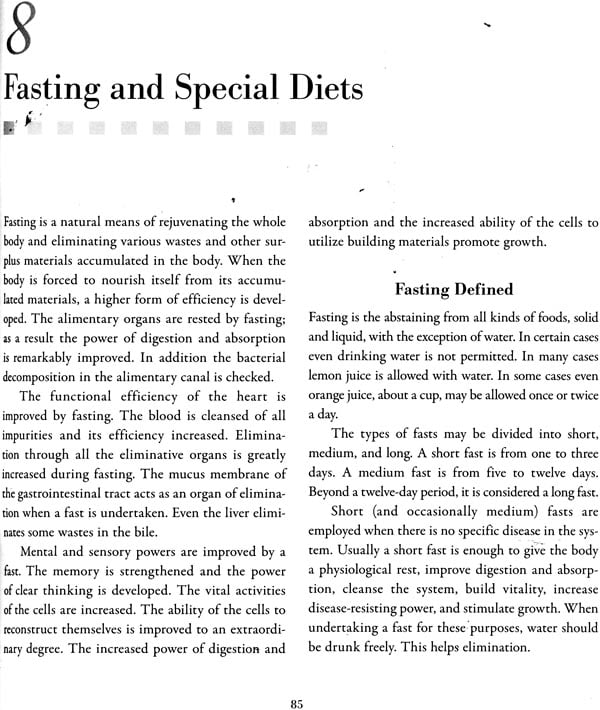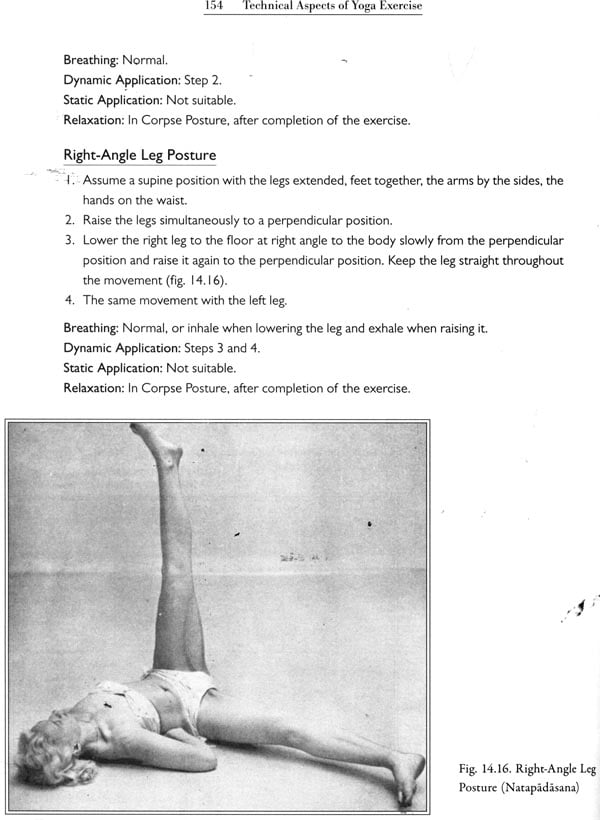
Advanced Hatha Yoga (Classic Methods of Physical Education and Concentration)
Book Specification
| Item Code: | NAP668 |
| Author: | Shyam Sundar Goswami |
| Publisher: | Inner Traditions, Vermont |
| Language: | English |
| Edition: | 2012 |
| ISBN: | 9781594774539 |
| Pages: | 304 (Throughuot B/W Illustrations) |
| Cover: | PAPERBACK |
| Other Details | 10.00 X 8.00 inch |
| Weight | 700 gm |
Book Description
Based on ancient Sanskrit works on Yoga as well as thousands of years of oral teachings, this Hatha Yoga classic moves beyond the introductory level of Yoga and provides illustrated instructions for many advanced asanas and other yogic techniques to build strength, stamina, and good posture- a necessary prerequisite for spiritual development.
Offering detailed exercise plans to help you develop your personal weekly yoga practice as well as techniques to target specific areas of the body, such as the abdominal muscles, this book also contains detailed instructions on many forms of pranayama (breath control), including alternate- nostril breathing, kapalabhati, and sahita, as well as meditative methods for developing your powers of concentration and mental discipline. With instructions on diet, fasting, internal cleansing, advanced sexual control, and strengthening the endocrine system, Sri S. S. Goswami's classic text presents the complete picture of an advanced Hatha Yoga lifestyle for a strong, vital, beautiful body and a balanced, harmonious, happy mind.
SHYAM SUNDAR GOSWAMI (1891-1978) was the founder of the Goswami Yoga Institute in Sweden, which opened in 1949 and was the first yoga school in Scandinavia. A disciple of the great yoga master Balak Bharati, he toured the world giving lectures and yoga demonstrations as well as, participating in scientific studies on the physical benefits of yoga practice. He also wrote Layayoga: The Definitive Guide to the Chakras and Kundalini.
It is with feelings of immense gratitude, honor, and responsibility that I write this foreword to the third edition of Sri Shyam Sundar Goswami's book, Hath Yoga. In this new edition,' now tided Advanced Hatha Yoga, special thanks are extended to Professor Coran Hedenstierna, Head of the Research Department of Clinical Physiology at the Uppsa1a University Hospital, Sweden.
I am very thankful for Inner Tradition's editorial team's constructive intiatives, in particular those of Laura Schlivek and Nancy Yeilding, whose meticulous editorial work has allowed most valuable improvements.
This long-overdue revision of Hatha Yoga is set apart by the addition of a more comprehensive index and a revised chapter on pranayama (chapter 21), with elaborations taken from material originally intended to be part of Sri Shyam Sundar Goswami's ambitious, five-volume Ha/ha Yoga-a project that only an enlightened Yoga master could undertake. It has not been deemed necessary to update the original chapter on diet (chapter 7) in the light of the many, often contradictory, theories and recommendations on nutrition.
Please note that for safety's sake certain exercises included in this manual require a competent instructor's supervision, while other advanced exercises, which are actually intended for spiritually oriented people, need a different level of supervision-that of a guru, or spiritual guide. Whet). ~e personal instruction of a teacher is necessary, it has been noted in the exercise directions.
Sri S. S. Goswami was remarkable for his outstanding personal achievements and for having presented astounding demonstrations of yogic bodily control in many locations throughout the world. He also shared with thousands of pupils the timeless experiences and values inherited from his own Spiritual achievements in both Hatha Yoga and Laya Yoga-two rather different yogic disciplines. The "Lion of Bengal," as an admiring maharaja once liked to call him, was also an exceptional man of action, a yogi who dedicated about seventy years of his life exclusively to the regular practice, study, and investigation of the vast field of Yoga.
Dedicated to the Lord of Yoga, scientifically presented as a valuable bridge between India's ancestral spiritual legacy and searching Western civilization, Sri S. S. Goswami's methodically elaborated Advanced Hatha Yoga has been for many years, and will surely continue to be, an exclusive reference for future generations, and as such replace the old manual Ha/ha Yoga Pradipikd, which-like two other major references, the Gheranda Samhita and the Siva Samhita-is derived from very ancient texts. Sri S. S. Goswami's holistic teachings on the vast subject of Yoga, and in particular. of the pragmatic philosophy of Hatha Yoga, are actually a manifestation of the Bhagavad Gita's triptych: knowledge, action, and love.
To all those who aspire to seriously undertake Hatha Yoga, Sri S. S. Goswami recalls the necessity to first adopt the tenfold vitalizing and cleaning processes known as yama and niyama .: This admonition is in harmony with the Yoga Bhashya Vivarana 2.29, whose tenet is that shanti-poise or peace of mind- is needed to qualify for Hatha Yoga's six further steps (angas). The ageless Hatha Yoga is the most adapted to modern lifestyles among existing Ashtanga Yoga paths.
As a practical philosophy, Hatha Yoga is particularly designed to fit typical representatives of the so- called Middle Way. It thus addresses those who stand with one foot in the frantic, centrifugal rhythm of social life and at the same time harbor genuine spiritual aspirations with the wish to enter into the evolutionary sphere of spiritual quest. Sri S. S. Goswarni's classic Advanced Hatha Yoga is a precious cognitive tool for harmoniously combining these two life styles.
As a personal message, I should say that for many years I've personally enjoyed, and still enjoy, in the fall of my life, the most appreciable and durable benefits from the regular practice of Sri Goswami's efficient philosophy of Harha Yoga. How? Mostly by improved immunity and vitality, strength and endurance, determination, peace of mind, mental power, and-still more important-the privilege of a spiritual teacher's lasting inspiration.
The author has commented, in an unpublished manuscript, upon lesser-known principles of Hatha Yoga. A substantial part of these and other valuable original teachings will be published in my forthcoming book titled Foundations of Yoga (Inner Traditions) •• along with one chapter dedicated to carana, one of the traditionally concealed methods, disclosed to the body of Yoga practitioners for the first time in the present book (see page 27).
BASILE CATOMERIS, a dedicated disciple of Sri Shyam Sundar Goswami, went on to head the Goswami Institute in Sweden, where he taught Goswami's style of Yoga to hundreds of students from different parts of the world.
During my visit a few years ago to London, Paris, Zurich, and other places in Europe, where I gave lectures on Yoga and demonstrations, I encountered an interest that was considerably greater than before the war, and I was repeatedly asked to give practical instructions in Yoga. Even medical men showed great interest and I had the opportunity to demonstrate before well-known surgeons and physicians the more advanced muscle control that is a part of Hatha Yoga. Hatha Yoga is not merely a means of acquiring a sound, strong, and vital body but also a reliable method of acquiring happiness and harmony and, above all, of developing the inner strength that enables a person to bear sorrow, pain, and failures with equanimity.
It has been my firm conviction that there exists a serious demand for a methodical and practical exposition of the Hatha Yoga system, with a view to the acquisition of physical strength and mental harmony. I have been asked to meet this demand by people very much interested in this matter, by friends and pupils, and have finally decided to write a book based upon personal experiences and fundamental studies.
This book is mainly based upon original works on Yoga in Sanskrit, the majority of which e.re only available in the form of unpublished manuscripts, but it is also based upon instructions that have been conveyed from teacher to pupil throughout generations for thousands of years.
Through personal experience I have been able to ascertain for myself the practical value of Hatha Yoga. From my very. childhood I was physically undeveloped; weak, and susceptible to disease. Neither medicines nor ordinary dietetic measures helped. Physical exercises improved my physical condition to some extent but did not increase my power of resistance. I searched everywhere for a possibility to improve my poor health and thus came in contact with a remarkable man, named Kali Singha, who at that time was about 110 years old. He was the first who drew my attention to Hatha Yoga, as a reliable means to give me what I needed. Singha was a dependable source, as he himself had practiced Hatha Yoga under the tuition of a guru. For some time I became his pupil, when I was seventeen.
About this time K. Rammurti 5aused a great sensation in India by his demonstrations of supporting an elephant upon his chest. He claimed that his strength was due to Yoga exercises and especially to certain breathing exercises. My interest was greatly stimulated, and I decided to dedicate my time exclusively to the study of Yoga. As Kali Singha had died, I looked for a new teacher, and found him in my guru, the great yogin Balaka Bharati, who initiated me in Hatha Yoga and-taught me the fundamentals of this unique system. My continuous exercises led to a quick and very satisfactory physical improvement. My muscles increased in size and strength, and finally. I could control their movements completely. When muscle was contracted, it was so hard that no impression could be made on it even with a pair of iron tongs. The muscles of the throat could be contracted to such an extent that throttling with an iron chain pulled by twelve men had no effect. I became more and more hardened against heat and cold.
Most important of all, I developed a power of resistance, which spared me every kind of illness. I became a healthy man. I realized that a weakened body was an obstacle for the efficient expression and working of the mental powers and that a clean and healthy body was an important condition for clear thinking and concentration. Further, I realized that only a person who is harmonious and well balanced in body and mind can develop spiritual powers to a maximum degree.
In India, where Yoga is considered to be a method for the spiritual progress of-humanity, by means of the right control of the body and mind," many institutions of more or less permanent character have sprung up. The pupils in these schools receive theoretical and practical instructions, adopt a new mode of life, and follow certain physical and moral rules. Their exercises become more and more difficult and, finally, they reach the highest stage of mental concentration. In this way Yoga has been imparted for thousands of years. It has thus been possible to collect experiences and make continuous observations to ascertain the effects of the methods on human subjects. According to my opinion, these methods must be considered to be much more reliable than any of the modern systems, which are based upon experiences and observations of a very short period of time. In my school in Kolkata, I have personally taught the Yoga method for thirty-five years, with good results, to a great number of pupils of both genders, different ages, and different conditions of health. Some people think that Yoga exercises are not suit- able for Western people. This has been contradicted by my own experience, which confirms that Western pupils have been able to master the yogic exercises equally as well as my Eastern pupils and to derive the same benefit. Some of them have reached a very high standard, as can be seen from the illustrations of many of the exercises in this book as performed by my Swedish pupils. The secret of success lies in determination, perseverance, and proper guidance. Another question has been raised about whether Yoga practice is necessarily very time-consuming. This time factor may be considered from two points of view: the time devoted in each day or week to the exercise and the time required to get results. For ordinary busy people three to five hours a week are sufficient, and most of them will be able to devote this much time for their physical health and mental revitalization. But those who want to reach perfection have to devote much more time. This is not only true with Yoga, but also with athletics sports, gymnastics, and, in fact, everything. We are not always conscious of how much time we waste every day on useless social pleasures and many other things. If we learn to economize time, it will not be difficult for us to spend the necessary time for rebuilding ourselves.
I would like to stress still another point-namely, that if the Yoga method seems to stand in contradiction to generally accepted views, it should not be discarded, for that Jeason, as being unscientific, useless, or even harmful. These methods, however strange and peculiar they may appear to the Western mind, have stood the test of time. Instead of throwing them aside as worthless, they should be studied and tested in clinical experiments that can be replicated for confirmation of the results, which I am sure will bring ultimate conviction of their worth.
Certain ideas and interpretations in this book may not be familiar to the way of thinking of many Western people, so I suggest that the reader first try to assimilate them by reading it carefully and thinking them over. I have tried my best to make the book as clear and palatable as possible, but still many readers may think that it is a highly specialized work. I know definitely that it is useless to deal with the subject more superficially simply to make it acceptable to the reader. Shallow knowledge will not help here. The reader must be ready to welcome new thoughts, because this is the only way' of self-expansion. After clear understanding of these ideas is gained, that knowledge can be translated into action by practicing the exercises and following other instructions contained in the book.
I sincerely believe that, with a normalized and controlled body and a vitalized and concentrated mind, attained through the practice of Yoga, life will appear more beauteous and charming, more lovable and enjoyable. Life will be worth living.
In Yoga a motionless, changeless, eternal principle has been recognized. From the yogic point of view, recognition of an intellectual verbosity, philosophical speculation, or psychological curiosity is not considered very important. Rather, the recognition valued by Yoga is entirely based on spiritual realization of the changeless principle, experienced as the ultimate reality. This realization is only possible when the subject-object experiences are transformed into a homogeneous pattern. The process involved is technically known as samddhi (super concentration). Consciousness at the human level is split into subjective and objective forms upon which rest the world experiences. By careful analysis we find that the subjective aspect of consciousness is composed of two component parts: I + my = I-my feeling. The main part is the "I" without "my." This means pure "I" without any trace of relation to objective consciousness. But at the common level it is almost impossible to isolate "I" from "my" and objects.
The subject apparently projects itself beyond its boundaries up to its objects. The projections are not without passion: they are fully saturated with desires, and the whole experience results in one of the three kinds of reaction: the experience of plea- sure, the experience of pain, or a temporary inertia combined with bewilderment when there is excessive pleasure or pain. Everything together is the world experience.
Desires arise in the subject and link it with objects. At the back of desire is interest. The subject feels interested in those objects that will give it enjoyment. How does the subject know that certain objects will give it enjoyment? The answer may be that the subject has prior experience. But how did the first experience come? The reply is usually given by stating that the whole phenomenon is "without beginning." The example of a seed tree is often cited in this connection. However, this interpretation is inadequate.
The first interest in objects is not due to any previous experience of the subject. It has been embedded in the subject and therefore it has no beginning. It is beyond cause and effect. Both the subject and the objects are born at the same moment, and before any experience of enjoyment due to contact with the object, the subject shows clear interest for objects. This interest is, so to speak, a memory of some blissful experience that the subject had before it was born. This means that consciousness beyond the subject-object phenomenon is in its own real form, which is bliss. This is Supreme Consciousness, which is being-consciousness-bliss. Without the recognition of Supreme Consciousness as the ultimate reality, the static background of all motional phenomena, the behavior of the subject cannot be rationally explained.
The cosmic phenomenon is the manifested Will of the unlimited, the indestructible quiescent Supreme Consciousness-a Will having the creative potency capable of being expressed fully. This is why the Will is called Sakti. Sakti is the massive con- centrated energy that is in the nature of consciousness and associated with bliss and at the same time capable of being expressed as creation. A dichotomy in the consciousness appears due to the influence of Maya, an aspect of Sakti in her creative mood. An object at the gross level is a compound of five mahabhutas (essentials), which is matter. In isolation from the compound, each of the mahabhutas is a form of nonmaterial subtle energy ultimately derived from still subtler and most concentrated forms of nonmaterial energy called tanmatras. Objects being dematerialized by the sensory processes are represented in the consciousness as heterogeneous images revolving around the "I." The constant molding of the objective aspect of consciousness into images that are of the sensory pattern is called vritti. It is the distracted state of the mind. When it is trans- formed into the single-intent state by the processes of dhararza (elementary concentration), dhydna (unbroken concentration), and samadhi (super concentration), a brighter form of mental life is evolved and gradually the mind is transformed into an extraordinary state in which, ultimately, the complete elimination of vritti occurs. It is a state that is beyond the knowledge of the known, a state of realization of the Unknown, a state of realization that is beyond realization. It is the state of asamprajnata samadhi.
According to Hatha Yoga, physical as well as mental factors are involved in concentration. Physical and mental need to function together harmoniously, along with a third factor: that of prana, the kinetic principle. When the movement potential of prana operates at the mahabhutas level, it expresses what is known as the phenomenon of life.
It is not a wise plan to live mostly in one aspect of life, ignoring the rest. A brilliant expression of mind in a sickly and devitalized body may appear very impressive, or a superbly developed body with a meager mental life may be quite charming. How- ever, such a mode of living will ultimately go wrong and break down. The mind and body are out of balance. To find out the correct balance is the starting point of Hatha Yoga. Prana is the balance beam on which the body and the mind can be properly balanced. But in our everyday life the pranic line is not straight as it should be, and this is why there is such a lack of harmony. When the pranic line is made straight, the problem is solved.
The functioning of the body as well as of the mind is entirely dependent on prana. All the organic movements of the living body, from the minutest to the grossest, are the expression of extra -physical subtler pranic movements. Hatha Yoga aims at gaining full control over the gross movements with a view to transforming the centrifugal forces operating in them into centripetal force. In this process of transformation, the mind is released, step by step, from physical influence; its distraction changes into single-intentness. The control process starts with the musculo-diaphragmatic movements, because it is easier to approach the other movements through them.
